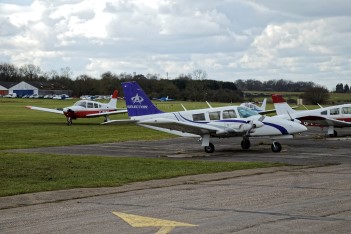Exploring the history of our airfields
27 January 2022

One of the greatest changes in warfare during the 20th century was the expansion of military aviation. Indeed, at the outbreak of World War I, there were just a handful of military airfields. However, by 1918, there were 301. And by the time victory was claimed by the allies at the end of World War II, there were over 400.
Many of these sites have since been decommissioned, however many still stand today, serving as training facilities for budding pilots and members of the public on experience days.
Below are just some of such historic airfields partnered with FlyDays.co.uk, who all have their own stories to tell, including links to legendary pilots, secret operations and Vulcans!
Stapleford Airfield
Stapleford first opened in 1933 for Hilman's Airways, a popular commercial airline company that later became part of British Airways. It was here that Amy Hilman, the pioneering pilot who was the first woman to fly solo from London to Australia, commenced many of her epic voyages.
However, with the outbreak of the Second World War in September 1939, one of the first priorities of the British High Command was to secure the country against any invasion plans that Hitler might already have. So, the Air Ministry acquired the airfield to carry out training for RAF personnel.
One of their most famous students was J.E. "Johnnie" Johnson, who became the RAF's top scoring pilot and reached the prestigious position of Air Vice Marshal. His training at Stapleford clearly prepared him well, as he took part in many successful offensive sweeps over German-occupied Europe from 1941 to 1944.
Doncaster Sheffield Airport
Doncaster Sheffield airport also owes its origins to military aviation. During the First World War, it was used as a base by the Royal Flying Corps as they looked to intercept German Zeppelins targeting industrial cities in the North of England.
However, it was during the Cold War that the airfield's significance rise as it was used to station Vulcan bombers. It was during this period of international crisis that engineers raced against time to design and develop this innovative example of British engineering to shoulder the Nation's nuclear deterrent.
Hucknall Aerodrome
In December 1940, the station was visited by a Dutch pilot, who claimed to be Captain van Lott, who had force landed in a Wellington bomber and claimed to be part of a special squadron that needed to borrow an aircraft to return him back to his base in Aberdeen. However, the pilot was in fact a Nazi, Franz von Werra, who had escaped from the prisoner of war camp at Swanick.
The British officers who encountered von Werra were not convinced by the bluffing German, so deliberately kept him near a roaring fire to try to get him to remove his suspicious, non-regulation flying overalls! While the British Duty Officer was trying to telephone the Scottish base, von Werra slipped out and made a run towards the Hurricanes he had previously seen parked close by. However, before he could take off, the Duty Officer re-appeared with his pistol.
This incredible story is no doubt one of the most audacious escape attempts by any prisoner under any circumstances throughout history. So much so, it was even chronicled in the British film The One That Got Away.



